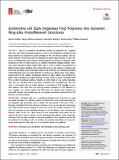Por favor, use este identificador para citar o enlazar a este item:
http://hdl.handle.net/10261/167461COMPARTIR / EXPORTAR:
 SHARE SHARE
 CORE
BASE CORE
BASE
|
|
| Visualizar otros formatos: MARC | Dublin Core | RDF | ORE | MODS | METS | DIDL | DATACITE | |

| Título: | Escherichia coli ZipA organizes FtsZ polymers into dynamic ring-like protofilament structures |
Autor: | Krupka, Marcin; Sobrinos-Sanguino, Marta CSIC ORCID ; Jiménez, Mercedes CSIC ORCID ; Rivas, Germán CSIC ORCID CVN ; Margolin, William | Palabras clave: | Escherichia coli Cell division Cell membranes FtsZ Polymers ZipA |
Fecha de publicación: | 19-jun-2018 | Editor: | American Society for Microbiology | Citación: | mBio 9 (3) e01008-18 (2018) | Resumen: | ZipA is an essential cell division protein in Escherichia coli. Together with FtsA, ZipA tethers dynamic polymers of FtsZ to the cytoplasmic membrane, and these polymers are required to guide synthesis of the cell division septum. This dynamic behavior of FtsZ has been reconstituted on planar lipid surfaces in vitro, visible as GTP-dependent chiral vortices several hundred nanometers in diameter, when anchored by FtsA or when fused to an artificial membrane binding domain. However, these dynamics largely vanish when ZipA is used to tether FtsZ polymers to lipids at high surface densities. This, along with some in vitro studies in solution, has led to the prevailing notion that ZipA reduces FtsZ dynamics by enhancing bundling of FtsZ filaments. Here, we show that this is not the case. When lower, more physiological levels of the soluble, cytoplasmic domain of ZipA (sZipA) were attached to lipids, FtsZ assembled into highly dynamic vortices similar to those assembled with FtsA or other membrane anchors. Notably, at either high or low surface densities, ZipA did not stimulate lateral interactions between FtsZ protofilaments. We also used E. coli mutants that are either deficient or proficient in FtsZ bundling to provide evidence that ZipA does not directly promote bundling of FtsZ filaments in vivo. Together, our results suggest that ZipA does not dampen FtsZ dynamics as previously thought, and instead may act as a passive membrane attachment for FtsZ filaments as they treadmill. IMPORTANCE: Bacterial cells use a membrane-attached ring of proteins to mark and guide formation of a division septum at midcell that forms a wall separating the two daughter cells and allows cells to divide. The key protein in this ring is FtsZ, a homolog of tubulin that forms dynamic polymers. Here, we use electron microscopy and confocal fluorescence imaging to show that one of the proteins required to attach FtsZ polymers to the membrane during E. coli cell division, ZipA, can promote dynamic swirls of FtsZ on a lipid surface in vitro. Importantly, these swirls are observed only when ZipA is present at low, physiologically relevant surface densities. Although ZipA has been thought to enhance bundling of FtsZ polymers, we find little evidence for bundling in vitro. In addition, we present several lines of in vivo evidence indicating that ZipA does not act to directly bundle FtsZ polymers. |
Descripción: | 15 p.-6 fig.-1 tab. | Versión del editor: | http://doi.org/10.1128/mBio.01008-18 | URI: | http://hdl.handle.net/10261/167461 | DOI: | 10.1128/mBio.01008-18 | E-ISSN: | 2150-7511 |
| Aparece en las colecciones: | (CIB) Artículos |
Ficheros en este ítem:
| Fichero | Descripción | Tamaño | Formato | |
|---|---|---|---|---|
| mBio-2018-Krupka-.pdf | Artículo principal | 3,5 MB | Adobe PDF |  Visualizar/Abrir |
CORE Recommender
PubMed Central
Citations
15
checked on 06-abr-2024
SCOPUSTM
Citations
24
checked on 16-abr-2024
WEB OF SCIENCETM
Citations
21
checked on 25-feb-2024
Page view(s)
294
checked on 19-abr-2024
Download(s)
233
checked on 19-abr-2024

